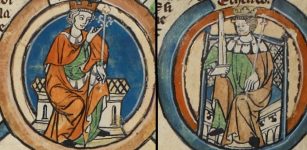Cuchulainn: Irish Mythical Hero And His Cruel Magical Spear Gae Bolg
A. Sutherland - AncientPages.com - For centuries, the Irish mythological tradition based on stories of the Pagan Celts was transmitted verbally until monks began to write them down in the 12th century in form of manuscripts.
"Cú Chulainn Riding His Chariot into Battle", illustration by J. C. Leyendecker in T. W. Rolleston's Myths & Legends of the Celtic Race, 1911
Among all of the Irish legends about adventures, voyages, great battles, invasions, and gods, perhaps Cu Chulainn is the main hero of the Ulster Cycle. In ancient Irish literature, the Ulster Cycle contains legends and tales dealing with the heroic age of the Ulaids, a people of northeast Ireland.
An important part of the Ulster Cycle describes the war between Ulster (Ulaid) and Connacht, two of Northern Ireland's most ancient provinces (in the early Middle Ages the island was divided into five provinces).
The life and the deeds of Cuchulainn (Cú Chulainn) have been described in many texts and of all the Ulster great champions none was more remarkable than a mythical figure – Cuchulainn.
Cuchulainn And His Magical Spear
He surprised with his divine, magical weapons he possessed and supernatural powers he could use as he wanted. It is said his mother was Dechtire, the daughter of the Druid Cathbad.
Young Cú Chulainn - as a boy, drawing by Stephen Reid (1912). Public Domain
She became pregnant in a dream, but his father’s identity is rather a mystery.
One story tells his father was the god Lugh, the hero of the Dananns, but we cannot take it for granted.
As a boy, he entered the Ulster king’s service and was trained by a famous legendary Scottish female warrior Scathach who taught Cuchulainn many heroic feats as standing on a lance in flight and gave him marvelous magic weapon the gae bolg, a kind of spear with thirty darts that could kill an enemy in a matter of seconds. Legend has it this terrible weapon made only one wound when entering, and immediately exploded into thirty small barbs once inside the enemy’s body.
This spear was Cuchulainn’s personal lethal weapon.
But Cuchulainn was not the only one who possessed an extraordinary spear. God Lugh had a similar weapon, which was called the “Invincible Spear” or the “Spear of Victory” and it had properties similar to a magical Sword of Nuada ("Sword of Light"), when thrown, it momentarily hit its target. This weapon was one of the lost Four Treasures of Tuatha de Danann.
The spear gae bolg of Cuchulainn was blazingly hot, and it became hotter the longer it was used. It was stored in a vat of water at night to keep it from catching fire and scorching the earth.
Why Was Cuchulainn An Unusual And Terrifying Warrior?
Many could witness how mad Cuchulainn was when he fought in the battle. When he was furious his body trembled violently and his hair stood on end. Ancient descriptions tell his muscles bulged and his body rotated within his skin. Perhaps the most puzzling part of his behavior relates to his eyes; one eye receded into his head, the other stood out huge and red on his cheek. His battle-cry drove people insane.
Whoever or whatever Cuchulainn was, he was a terrifying figure in battle, and it is known that he was one of the most furious berserkers.
How Did Mighty Warrior Cuchulainn Meet His End?
Cuchulain was a great hero but he had plenty of enemies and one of them was Queen Maeve of Connaught.
Queen Maev, the warrior queen of Connacht in Irish mythology, by J. C. Leyendecker. Credit: Joseph Christian Leyendecker (1874 - 1951) - T. W. Rolleston, Myths and Legends of the Celtic Race, Public Domain
When Cuchulainn became the leader of the Red Branch Knights, Queen Maeve offered him great rewards and gold if he would not to go into battle against her, but he refused.
Cuchulainn was blood-thirsty and enjoyed battles, but there was one decisive fight that sealed his fate.
When he killed the Druid Calatin, his children (six sorcerers) sought revenge for their father’s death. Together with Queen Maeve they plotted to kill Cuchulainn. They came up with a cunning plan to create an illusion of a battle, knowing perfectly well that Cuchulainn could not resist a good fight.
Cuchulainn was tricked to believe that Ulster was in danger. As he left his place of safety, he was struck by a magic spear thrown by one of the sorcerers.
Being a proud and courageous warrior, Cuchulainn wanted to meet his enemies face to face despite being mortally wounded. He wanted to die with honor. He stood up and tied himself to rock but for three days no one approached him.
Finally, war goddess Badb took the form of a crow and landed on his shoulder but he did not move.
The great mighty warrior and hero, Cuchulainn was dead.
Written by A. Sutherland - AncientPages.com Staff Writer
Copyright © AncientPages.com All rights reserved. This material may not be published, broadcast, rewritten or redistributed in whole or part without the express written permission of AncientPages.com
Expand for referencesMore From Ancient Pages
-
 Rare Medieval Tattoo Depicting A Christogram Unearthed In Ghazali, Sudan
Archaeology | Nov 9, 2023
Rare Medieval Tattoo Depicting A Christogram Unearthed In Ghazali, Sudan
Archaeology | Nov 9, 2023 -
 Strange Ancient Underwater Yellow Brick Road Discovered Of The Hawaiian Islands
News | May 11, 2022
Strange Ancient Underwater Yellow Brick Road Discovered Of The Hawaiian Islands
News | May 11, 2022 -
 Skeleton Of Last Trojan Discovered – Ancient City Of Troy May Have Been A Religious Sanctuary – Archaeologists Say
Archaeology | Sep 21, 2018
Skeleton Of Last Trojan Discovered – Ancient City Of Troy May Have Been A Religious Sanctuary – Archaeologists Say
Archaeology | Sep 21, 2018 -
 Mysterious Medes: Was It An Ancient City Of Ecbatana?
Archaeology | Jul 3, 2020
Mysterious Medes: Was It An Ancient City Of Ecbatana?
Archaeology | Jul 3, 2020 -
 Gravitational Waves Shed Light On The Mysterious Antikythera Mechanism
News | Jun 29, 2024
Gravitational Waves Shed Light On The Mysterious Antikythera Mechanism
News | Jun 29, 2024 -
 Mosaics Discovered In Ancient Galilean Jewish Village
Archaeology | Jul 10, 2018
Mosaics Discovered In Ancient Galilean Jewish Village
Archaeology | Jul 10, 2018 -
 Geb – Egyptian God Of Earth And Member Of The Ennead – His Laughter Created Earthquakes
Egyptian Mythology | Feb 12, 2019
Geb – Egyptian God Of Earth And Member Of The Ennead – His Laughter Created Earthquakes
Egyptian Mythology | Feb 12, 2019 -
 Well-Preserved Neolithic Settlement Discovered Near Kutná Hora, Czech Republic
Archaeology | Aug 2, 2024
Well-Preserved Neolithic Settlement Discovered Near Kutná Hora, Czech Republic
Archaeology | Aug 2, 2024 -
 1,300-Year-Old Church Discovered Near Mt. Tabor In Lower Galilee, Israel
Archaeology | Jul 28, 2020
1,300-Year-Old Church Discovered Near Mt. Tabor In Lower Galilee, Israel
Archaeology | Jul 28, 2020 -
 Revealing 1,200 Years Of Arctic Canadian Cultures And Settlements In Canada
Archaeology | Jul 11, 2024
Revealing 1,200 Years Of Arctic Canadian Cultures And Settlements In Canada
Archaeology | Jul 11, 2024 -
 Khepri – Egyptian Progenitor God, Spirit Of Life, Resurrection And The Rising Sun
Egyptian Mythology | May 14, 2020
Khepri – Egyptian Progenitor God, Spirit Of Life, Resurrection And The Rising Sun
Egyptian Mythology | May 14, 2020 -
 Shin-Au-Av – Secret Ancient Underground City Hidden Beneath Death Valley
Featured Stories | Jun 6, 2024
Shin-Au-Av – Secret Ancient Underground City Hidden Beneath Death Valley
Featured Stories | Jun 6, 2024 -
 Amage: Sarmatian Warrior Queen/Regent Who Impressed With Remarkable Military Skills
Featured Stories | May 23, 2023
Amage: Sarmatian Warrior Queen/Regent Who Impressed With Remarkable Military Skills
Featured Stories | May 23, 2023 -
 Remarkable 2,000-Year-Old Smoke-Absorbing Lamps Reducing Pollution Discovered
Archaeology | Nov 12, 2015
Remarkable 2,000-Year-Old Smoke-Absorbing Lamps Reducing Pollution Discovered
Archaeology | Nov 12, 2015 -
 Ignored Archaeological Discovery At Puma Punku That Could Re-Write Ancient History
Ancient Mysteries | May 11, 2020
Ignored Archaeological Discovery At Puma Punku That Could Re-Write Ancient History
Ancient Mysteries | May 11, 2020 -
 Bizarre Meat-Eating Dinosaur Found In Classic Fossil Site In Egypt’s Sahara Desert
Archaeology | Jun 9, 2022
Bizarre Meat-Eating Dinosaur Found In Classic Fossil Site In Egypt’s Sahara Desert
Archaeology | Jun 9, 2022 -
 On This Day In History: Battle Of Marton, Part Of Viking Invasions Of England Took Place – On Mar 22, 871
News | Mar 22, 2017
On This Day In History: Battle Of Marton, Part Of Viking Invasions Of England Took Place – On Mar 22, 871
News | Mar 22, 2017 -
 Secret Hidden Freemasonic Messages Concealed In Ancient Egyptian Artifacts And Roman Works – Curious Stellar Symbol – Part 2
Ancient Mysteries | Feb 23, 2022
Secret Hidden Freemasonic Messages Concealed In Ancient Egyptian Artifacts And Roman Works – Curious Stellar Symbol – Part 2
Ancient Mysteries | Feb 23, 2022 -
 Sumerian Plaque Dedicated To King Ur-Nanshe, The Founder Of The 1st Dynasty Of Lagash
Artifacts | Dec 5, 2018
Sumerian Plaque Dedicated To King Ur-Nanshe, The Founder Of The 1st Dynasty Of Lagash
Artifacts | Dec 5, 2018 -
 Hypatia Of Alexandria – Brilliant, Controversial Scientist And Her Dramatic End
Featured Stories | Jan 7, 2019
Hypatia Of Alexandria – Brilliant, Controversial Scientist And Her Dramatic End
Featured Stories | Jan 7, 2019



